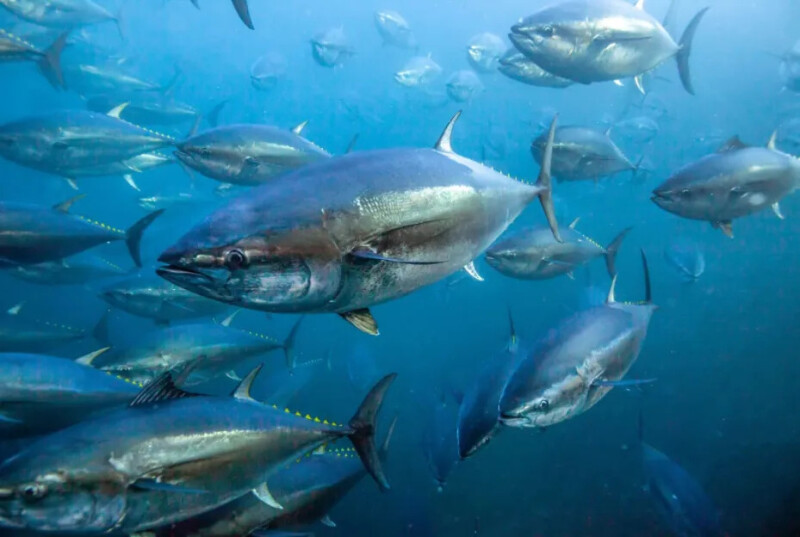According to NOAA Fisheries, commercial Pacific bluefin tuna fishermen in the United States will be able to harvest nearly 80 percent more tuna in 2025-2026, thanks to new catch limits set by the Inter-American Tropical Tuna Commission. The decision, made in September, follows an encouraging stock assessment by the International Scientific Committee for Tuna and Tuna-Like Species, which found the Pacific bluefin population rebuilt a decade ahead of schedule. This increase offers a major boost for U.S. commercial and recreational fisheries, particularly in Southern California, after years of strict conservation efforts.
The Inter-American Tropical Tuna Commission increased catch limits during a meeting in Panama in early September.
U.S. fishermen harvest Pacific bluefin tuna using hook-and-line, purse seine, and drift gillnet gear and land their catch mainly in Southern California ports. Additionally, increases in commercial catch limits will benefit recreational anglers who also catch Pacific bluefin off Southern California. The Inter-American Tropical Tuna Commission resolution that increased commercial catches also called for consistent management of sport fishing.
In 2022, U.S. commercial fishers harvested 368 metric tons, or more than 800,000 pounds, of Pacific bluefin tuna. They earned more than $2.2 million for the catch. The 2-year catch limit for 2025–26 is increasing almost 80 percent, to 1,822 metric tons from 1,017 in 2023–24. That means the U.S. fleet can bring more Pacific bluefin tuna to the docks and seafood markets. This would be a welcome change for captains, crew, and seafood distributors after more than a decade of belt-tightening in the fishery.
“We rebuilt the stock as a result of stringent management measures put in place on both sides of the Pacific, and the effort was not just thanks to scientists and fishery managers. We have to acknowledge the efforts the fishing industry has taken to ensure harvests remain sustainable,” said Ryan Wulff, Assistant Regional Administrator for the NOAA Fisheries West Coast Region and Alternate U.S. Commissioner to the Inter-American Tropical Tuna Commission.
“The rebuilding of the Pacific bluefin stock is not only a success from a biological perspective but is also a success for the fishing communities and consumers, leading to greater economic opportunity and more U.S. seafood available for U.S. plates,” Wulff said.
Decades of overfishing depressed the abundance of Pacific bluefin tuna to historically low levels from 2009 to 2012. This precipitous decline sparked international steps to drastically reduce fishing across the Pacific, giving the commercially prized species a chance to stabilize and rebuild. That led to the rebuilding of the population a decade ahead of schedule.
The next challenge for the industry will be to rebuild markets—specifically within the United States—and educate consumers that the Pacific bluefin tuna population is rebuilt ahead of expectations.
Many Countries, One Stock
Pacific bluefin tuna are a Highly Migratory Species, whose habitat mostly spans the temperate waters of the North Pacific—from East Asia to the North American West Coast. The Inter-American Tropical Tuna Commission is a regional fishery management organization that manages catches of tuna and tuna-like species in the eastern Pacific. The United States and Mexico are the only countries in the eastern Pacific that harvest Pacific bluefin. The Western & Central Pacific Fisheries Commission manages Pacific bluefin tuna havests throughout the rest of the Pacific.
Both organizations adopt bluefin tuna management and conservation measures by consensus, based on science produced by the seven-country International Scientific Committee for Tuna and Tuna-Like Species in the North Pacific Ocean. This international coordination encompasses the migration pattern of Pacific bluefin across a 6,000-mile swath across the North Pacific. It spans their spawning grounds in the Sea of Japan to abundant feeding grounds off Southern California and Baja Mexico. Another subset of Pacific bluefin also travel south from the spawning ground to waters between Australia and New Zealand.
Japan and Mexico catch the most bluefin across its range. Mexico has a highly developed fishery that uses net pens to raise 1- to 2-year old fish in captivity until they are ready for harvest. The Commission will set new catch limits for the Western Pacific at their next meeting in November 2024.
Rebuilt stock, rebuilding markets
Large highly migratory species such as swordfish, Pacific bluefin, and other tunas have rebounded in the past decade through effective fishery management and international cooperation. Consumer sentiment and domestic markets are still adjusting to these successes.
“Fishermen are working to rebuild relationships with processors, restaurants, and other customers,” said Michael Rubino, NOAA Fisheries Senior Advisor for Seafood Strategy. “they will, in their turn, have to rebuild and potentially educate their consumer base, often consisting of environmentally minded consumers who may be unaware of bluefin's improved status. Increased catch limits represent market opportunity, but we also have to maintain and in some cases rebuild working waterfront infrastructure to land and process increased catches.”
NOAA’s National Seafood Strategy includes actions aimed at strengthening the resilience of the sector and the communities that depend on fishing businesses. The strategy guides NOAA Fisheries staff in working with fishermen and seafood producers around the country to address challenges posed by climate change, market disruptions such as what was caused by the coronavirus pandemic, international trade, and the need to modernize and recapitalize fishing vessels, processing plants, and other US seafood infrastructure.
To read more, visit NOAA Fisheries.







